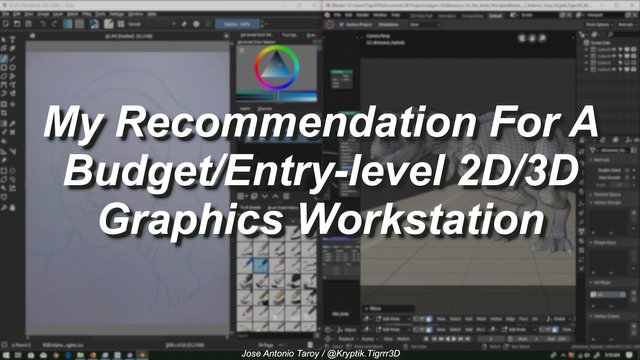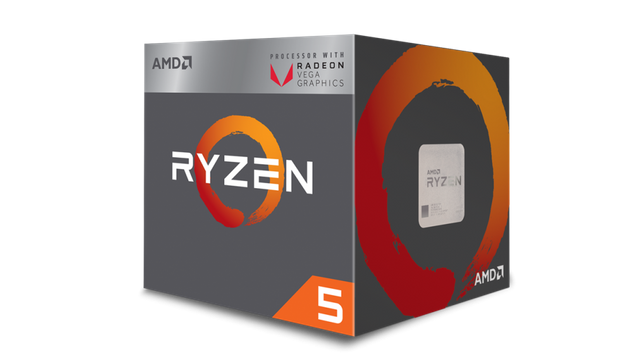Building An Entry-level 2D/3D Graphics Workstation Systems
You Don't Need to Spend A Fortune to Get Started on 3D Graphics and Animation

I often get asked in Facebook what kind of hardware I use to create 3D graphics and animation. People often think that I have an expensive computer to work with.
That may be true in the case of the faster, and more powerful machine I use for my professional creative output. It's a brute, and at the heart of its processing power are a pair of GeForce GTX 1060 cards, for heavy GPU rendering.
But, for the stuff I do that end up getting posted here in my blog, they're often surprised when they find out that it's just a lightweight, six-year old desktop computer, that only has about one-third the processing power of its more powerful partner.
So, after finding out what I have, they often ask me to list up the specs of a current generation entry-level machine that they could use to learn 2D and 3D graphics and animation software, without having to shell out a lot of money.
I often tell them it would cost at least ₱30,000.00, or less if they already have some parts, or a working system, that they would just need to upgrade where needed.
And for the purpose of this blog, I will assume a simple scenario in which the one who needs such a machine already has a monitor, mouse, and keyboard, and wants a system comprised of brand-new parts with a good upgrade path in the future.
AMD Ryzen 2400G APU - The Little Chip That Packs A Potent Punch

For this lightweight graphics workstation, I chose the more powerful version of a processor design from AMD, known as the APU, or Accelerated Processing Unit.
An APU is a microprocessor design developed by AMD in which the processor (the chip that is the brain, the computer itself) and the graphics processor (the chip that powers video cards) are combined in one chip.
This results in a processor design that's suitable for portable solutions such as laptops and notebooks, and for budget-friendly desktop computer systems for people who need a computer right away, but do not need the power of a discrete video card, or lack the funds for the purchase of such a video card for display output and graphical (graphics design/animation, video playback, gaming) needs.
The onboard GPU of an APU can handle all your display and graphics needs, as long as you know its limitations, and don't dream of making a VFX-heavy Hollywood blockbuster with it someday.
My Recommended Specs for A Machine That I Would Be Comfortable Using For Serious Content Creation For My Blog
- Processor: AMD Ryzen 5 2400G 4-Core 8-Thread 3.5-3.90GHz Processor - ₱8,600.00
- Motherboard: Gigabyte B450M DS3H AM4 Motherboard - ₱4,160.00
- Memory: Corsair Vengeance RGB 16GB Dual DDR4 3200Mhz - ₱9,500.00
- Power Supply: Seasonic S12II-620 620Watts 80Plus Bronze - ₱3,250.00
- Hard Drive: Seagate 1TB Barracuda ST1000DM010 (SATA 6 Gb/s) - ₱2,250.00
- Case: Trendsonic FC-F61AS w/ psu 600w Case - ₱1,150.00
These prices were taken from DynaQuest PC, a computer store nearby that I've been buying parts from since 2012. I chose Gigabyte as the brand of motherboard to buy, not just because I use it, but also because of its dual BIOS feature.
And although this blog entry was intended to answer the questions of my compatriots, my readers from abroad, especially those from Third World countries, can still use it as a reference. Current FOREX rate of Philippine peso to USD is ₱53 to $1.
A Sample of What This Little Beast of A Chip Can Do
I was looking for information on how a system based on this processor would fare as a workstation for light to moderate 3D graphics work, similar to what I do to create my other posts here.
Then I stumbled upon this Youtube video that showed me exactly what I wanted to see, and wanted to show you. This validated my choice for this processor to power such an entry-level system.
In the video, the demonstrator used VRED Professional, a high-end automobile design, visualization, virtual prototyping, and rendering solution from graphics giant, Autodesk, and costs US $11,470.00 for an annual license.
Now, isn't that impressive? It's doing on-screen progressive 3D GPU rendering without the benefit of a discrete video card's GPU. Compare it with the video below.
GPU 3D Rendering Demo I Made Back in 2014
I made this demo back in February 2014, with Blender's Cycles renderer. It's not meant to demonstrate the power of this first-generation APU (which is weak compared to today's APUs), but to show how the onboard GPU of the APU can work alongside the GPU of a discrete video card, and one made by AMD's number one competitor, Nvidia, to boot!
Wait, what?! Say again? Two GPUs from two competing giant chipmakers working together?
Yes, people, you read me correctly. That setup is called a multi-GPU system, and it was configured to have the APU handle the display and video needs of the system, and the companion GeForce GTX 750 Ti doing all the near real-time 3D rendering seen in the video.
Even though this video was done with another GPU doing the 3D rendering, this kind of performance is what you will be getting from the onboard GPU of the Ryzen 2400G, and perhaps even smoother than it. You get to have that kind of graphics processing power, without having to buy a video card for it.
Conclusion
As you can see, I am obviously a big fan of AMD's APU architectures, with my first-generation APU still getting some nice 3D graphics action since the day I bought it in Sept. 2012. And being a user of this type of processor, I am obviously highly-qualified to recommend it for serious graphics use, as long as it is not going to be used for heavy professional production. This little chip won't let you down.
So, I guess this has convinced you now of the power of AMD's APU offerings. As of this writing, I learned just a few hours ago that AMD has just demonstrated their latest CPU and GPU processor architectures built on the 7nm manufacturing process that they've been touting for the past two years.
This means that even more powerful APUs, CPUs, and GPUs will be available some time next year, providing you with a nice upgrade, should you decide to stick with an APU system. But, make no mistake, the system I've enumerated above allows you to install more powerful processors onto the motherboard, should you decide to go that route someday.
That would mean the purchase of a video card too, but it's something you would only get into once you've decided to go "pro" and have a nice system that can easily handle the more demanding tasks of professional graphics and animation work.
So, there you go. Here is proof that a little David of a chip can take on a Goliath of a task. And I always root for the underdog. I will create an updated blog about this system a few months from now, on how to slowly upgrade it into a mid-range or high-end graphics workstation someday, when your funds permit.
Thank you for reading, and I hope you found this post informative, or even helpful in some way, especially if you are looking to build a system to learn graphics on, for Steemit graphics design services someday. God Bless you all, and have a nice day.
This blog was created with eSteem Surfer, Blender, and GIMP, on a six-year old AMD APU desktop computer that I've dedicated for Steemit blogging and content creation.
I have a bunch of new stuff on the way, and currently in progress are blogs about the books I have in my library, creature animations, the 2D/3D graphical elements for my own branding here, as well as Jacinta's portrait.
Yeah, I jumped onto GPU rendering a while back with my GTX 1060. I also had to change my workflow, but even back in the day I was using Direct X 11 to do most of my rendering, now I have switched my workflow to also use Unreal Engine - which has dropped rendering time and machine power requirements a huge amount. It's nice to have one machine do it all and spend more time on the creative aspect.
What's more though is regardless of hardware, with something decent and a good workflow you can pull off a lot with very little. And all for free - including Blender and a personalized fork I use called Bforartists with the free #ue4. Sometime a cheaper gaming card can still get you 4K renders with decent believable results, realtime writing to disc at 18sec per frame - with a machine half the size as the one you've written about and recommend (which would be mine!)
So thanks again for breaking down the hardware requirements for great artistic work.
This post has received a 12.09 % upvote from @boomerang.
You got a 15.56% upvote from @shares courtesy of @kryptik.tigrrr3d! This is a service sponsored by @Yehey. Please consider voting for @Yehey as one of your Witness. Use this short URL link https://on.king.net/witness simply click and vote, this will redirect to steem connect for secure connection.
If you need an extra upvote, join us at https://SteemChat.com discord server. Or simply hang out and meet new friends with common interest.
WANTED SP DELEGATION. Let your Steem Powers (SP) works for you. Delegate SP to receive daily payouts. Choose the amount of your delegation. Start small or go big, it's all up to you.
100 SP | 200 SP | 500 SP | 1000 SP | 2000 SP | 3000 SP | 5000 SP | 10000 SP | 20000 SP | 50000 SP | 100000 SP | 500000 SP | 1000000 SP
Have a fun day.
@Shares - Keep Steeming for a better future.
Congratulations @kryptik.tigrrr3d! You have completed the following achievement on the Steem blockchain and have been rewarded with new badge(s) :
Click here to view your Board of Honor
If you no longer want to receive notifications, reply to this comment with the word
STOP